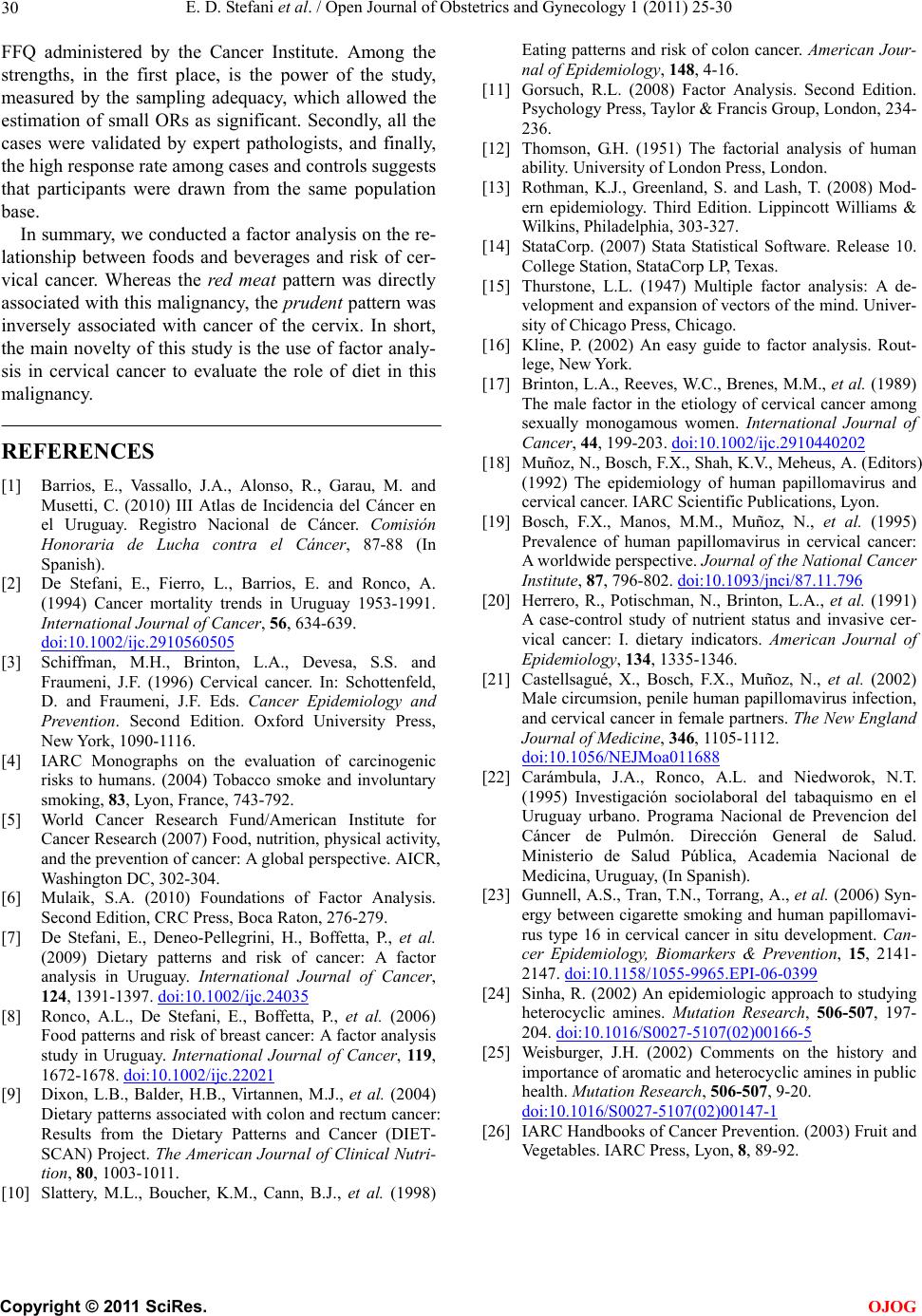
E. D. Stefani et al. / Open Journal of Obstetrics and Gynecology 1 (2011) 25-30
30
FFQ administered by the Cancer Institute. Among the
strengths, in the first place, is the power of the study,
measured by the sampling adequacy, which allowed the
estimation of small ORs as significant. Secondly, all the
cases were validated by expert pathologists, and finally,
the high response rate among cases and controls suggests
that participants were drawn from the same population
base.
In summary, we conducted a factor analysis on the re-
lationship between foods and beverages and risk of cer-
vical cancer. Whereas the red meat pattern was directly
associated with this malignancy, the prudent pattern was
inversely associated with cancer of the cervix. In short,
the main novelty of this study is the use of factor analy-
sis in cervical cancer to evaluate the role of diet in this
malignancy.
REFERENCES
[1] Barrios, E., Vassallo, J.A., Alonso, R., Garau, M. and
Musetti, C. (2010) III Atlas de Incidencia del Cáncer en
el Uruguay. Registro Nacional de Cáncer. Comisión
Honoraria de Lucha contra el Cáncer, 87-88 (In
Spanish).
[2] De Stefani, E., Fierro, L., Barrios, E. and Ronco, A.
(1994) Cancer mortality trends in Uruguay 1953-1991.
International Journal of Cancer, 56, 634-639.
doi:10.1002/ijc.2910560505
[3] Schiffman, M.H., Brinton, L.A., Devesa, S.S. and
Fraumeni, J.F. (1996) Cervical cancer. In: Schottenfeld,
D. and Fraumeni, J.F. Eds. Cancer Epidemiology and
Prevention. Second Edition. Oxford University Press,
New York, 1090-1116.
[4] IARC Monographs on the evaluation of carcinogenic
risks to humans. (2004) Tobacco smoke and involuntary
smoking, 83, Lyon, France, 743-792.
[5] World Cancer Research Fund/American Institute for
Cancer Research (2007) Food, nutrition, physical activity,
and the prevention of cancer: A global perspective. AICR,
Washington DC, 302-304.
[6] Mulaik, S.A. (2010) Foundations of Factor Analysis.
Second Edition, CRC Press, Boca Raton, 276-279.
[7] De Stefani, E., Deneo-Pellegrini, H., Boffetta, P., et al.
(2009) Dietary patterns and risk of cancer: A factor
analysis in Uruguay. International Journal of Cancer,
124, 1391-1397. doi:10.1002/ijc.24035
[8] Ronco, A.L., De Stefani, E., Boffetta, P., et al. (2006)
Food patterns and risk of breast cancer: A factor analysis
study in Uruguay. International Journal of Cancer, 11 9,
1672-1678. doi:10.1002/ijc.22021
[9] Dixon, L.B., Balder, H.B., Virtannen, M.J., et al. (2004)
Dietary patterns associated with colon and rectum cancer:
Results from the Dietary Patterns and Cancer (DIET-
SCAN) Project. The American Journal of Clinical Nutri-
tion, 80, 1003-1011.
[10] Slattery, M.L., Boucher, K.M., Cann, B.J., et al. (1998)
Eating patterns and risk of colon cancer. American Jour-
nal of Epidemiology, 148, 4-16.
[11] Gorsuch, R.L. (2008) Factor Analysis. Second Edition.
Psychology Press, Taylor & Francis Group, London, 234-
236.
[12] Thomson, G.H. (1951) The factorial analysis of human
ability. University of London Press, London.
[13] Rothman, K.J., Greenland, S. and Lash, T. (2008) Mod-
ern epidemiology. Third Edition. Lippincott Williams &
Wilkins, Philadelphia, 303-327.
[14] StataCorp. (2007) Stata Statistical Software. Release 10.
College Station, StataCorp LP, Texas.
[15] Thurstone, L.L. (1947) Multiple factor analysis: A de-
velopment and expansion of vectors of the mind. Univer-
sity of Chicago Press, Chicago.
[16] Kline, P. (2002) An easy guide to factor analysis. Rout-
lege, New York.
[17] Brinton, L.A., Reeves, W.C., Brenes, M.M., et al. (1989)
The male factor in the etiology of cervical cancer among
sexually monogamous women. International Journal of
Cancer, 44, 199-203. doi:10.1002/ijc.2910440202
[18] Muñoz, N., Bosch, F.X., Shah, K.V., Meheus, A. (Editors)
(1992) The epidemiology of human papillomavirus and
cervical cancer. IARC Scientific Publications, Lyon.
[19] Bosch, F.X., Manos, M.M., Muñoz, N., et al. (1995)
Prevalence of human papillomavirus in cervical cancer:
A worldwide perspective. Journal of the National Cancer
Institute, 87, 796-802. doi:10.1093/jnci/87.11.796
[20] Herrero, R., Potischman, N., Brinton, L.A., et al. (1991)
A case-control study of nutrient status and invasive cer-
vical cancer: I. dietary indicators. American Journal of
Epidemiology, 134, 1335-1346.
[21] Castellsagué, X., Bosch, F.X., Muñoz, N., et al. (2002)
Male circumsion, penile human papillomavirus infection,
and cervical cancer in female partners. The New England
Journal of Medicine, 346, 1105-1112.
doi:10.1056/NEJMoa011688
[22] Carámbula, J.A., Ronco, A.L. and Niedworok, N.T.
(1995) Investigación sociolaboral del tabaquismo en el
Uruguay urbano. Programa Nacional de Prevencion del
Cáncer de Pulmón. Dirección General de Salud.
Ministerio de Salud Pública, Academia Nacional de
Medicina, Uruguay, (In Spanish).
[23] Gunnell, A.S., Tran, T.N., Torrang, A., et al. (2006) Syn-
ergy between cigarette smoking and human papillomavi-
rus type 16 in cervical cancer in situ development. Can-
cer Epidemiology, Biomarkers & Prevention, 15, 2141-
2147. doi:10.1158/1055-9965.EPI-06-0399
[24] Sinha, R. (2002) An epidemiologic approach to studying
heterocyclic amines. Mutation Research, 506-507, 197-
204. doi:10.1016/S0027-5107(02)00166-5
[25] Weisburger, J.H. (2002) Comments on the history and
importance of aromatic and heterocyclic amines in public
health. Mutation Research, 506-507, 9-20.
doi:10.1016/S0027-5107(02)00147-1
[26] IARC Handbooks of Cancer Prevention. (2003) Fruit and
Vegetables. IARC Press, Lyon, 8, 89-92.
C
opyright © 2011 SciRes. OJOG